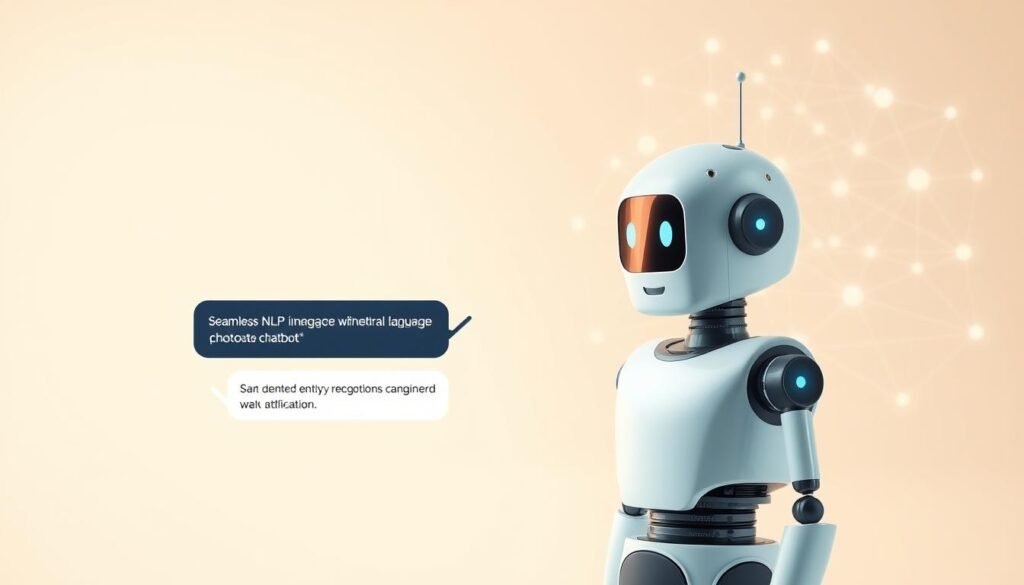Are you ready to explore AI chatbot development with Python? This guide will show you how to make your first AI chatbot from start to finish. You’ll learn the key ideas, tools, and methods for creating a working chatbot. ullamcorper mattis, pulvinar dapibus leo.

This step-by-step tutorial will help you get hands-on with python chatbot tutorial. You’ll see how to make your own chatbot. It doesn’t matter if you’re new or have experience. This guide will help you start with create ai chatbot python projects.
Key Takeaways
- Understand the basics of AI chatbot development using Python.
- Learn how to design and implement a conversational AI model.
- Discover the essential tools and libraries required for python chatbot development.
- Gain insights into deploying and testing your AI chatbot.
- Explore the potential applications and future prospects of AI chatbots.
Understanding AI Chatbots: What They Are and How They Work
Before we start, let’s understand what AI chatbots are and how they work. AI chatbots are advanced software that mimic human conversations. They can talk to users through text or voice.
Types of AI Chatbots
There are two main types of AI chatbots. Rule-based chatbots use set rules to answer questions. AI-powered chatbots, on the other hand, learn from user interactions. When making a chatbot with Python, tools like NLTK and SpaCy help with understanding language.
Common Use Cases for Python Chatbots
Python chatbots are useful in many areas. They can help with customer service, tech support, and even entertainment. They can work around the clock, thanks to messaging platforms. Using a python chatbot library or python chatbot framework makes building them easier.
How AI Powers Modern Conversational Interfaces
AI is key to today’s chatbots. It lets them understand and handle human language. This includes recognizing what users mean and what they’re asking for. By using AI, chatbots can get better with time. They learn from each conversation, making them more helpful to users. Knowing these points is important when you’re learning to make an AI chatbot with Python. It helps you design and build a better chatbot.
Setting Up Your Python Environment for Chatbot Development
Starting your first AI chatbot requires setting up your Python environment. This is the first step in your project. You need the right tools and libraries to begin.
Required Python Packages and Dependencies
To make a chatbot in Python, you must install certain packages. You’ll need NLTK, SpaCy, and TensorFlow. These libraries are key for natural language processing and machine learning.
Creating a Virtual Environment
Creating a virtual environment is a good idea. It helps manage your project’s dependencies. You can use venv or conda to create one. This keeps your project’s dependencies separate from your system’s Python environment. https://www.youtube.com/watch?v=1lwddP0KUEg
Installing Essential Libraries
After setting up your virtual environment, install the needed libraries. For example, install NLTK with pip install nltk. Follow the same process for SpaCy and other libraries. Make sure to read the installation instructions carefully to avoid problems. By following these steps, you’ll have a Python environment ready for chatbot development. Now, you can start building your chatbot using Python and the libraries you’ve installed.
Choosing the Right Framework for Your Chatbot
When you’re building a chatbot in Python, picking the right framework is key. The framework you choose can really affect how your chatbot works and performs. Python has many libraries for making chatbots. Each one has its own strengths and uses. Knowing about these options helps you make a smart choice.
Popular Python Chatbot Libraries
Some top libraries for chatbots in Python are NLTK, SpaCy, and Transformers. NLTK is known for its deep NLP tools, like breaking down text and analyzing feelings. SpaCy is great for understanding text deeply, making it fast and efficient.
Comparing NLTK, SpaCy, and Transformers
Choosing between NLTK, SpaCy, and Transformers depends on your project’s needs. Here’s a quick look at what each offers:
| Library | Primary Use | Key Features |
|---|---|---|
| NLTK | NLP tasks, text processing | Tokenization, stemming, corpora |
| SpaCy | Industrial NLP, entity recognition | High-performance processing, entity recognition |
| Transformers | State-of-the-art NLP models | Pre-trained models like BERT, RoBERTa |
Selecting Based on Your Project Requirements
Think about what your project needs when picking a library. NLTK is good for simple chatbots. For more complex tasks, SpaCy or Transformers might be better.  The best framework for you will depend on your project’s needs. This includes the NLP level, chatbot complexity, and your team’s skills.
The best framework for you will depend on your project’s needs. This includes the NLP level, chatbot complexity, and your team’s skills.
How to Create AI Chatbot in Python: Step-by-Step Implementation
With Python, you can make a smart AI chatbot step by step. This guide will show you how to build a working AI chatbot from the start.
Designing Your Chatbot’s Architecture
First, plan your chatbot’s design. Think about its purpose, who it’s for, and what kind of talks it will have. A good plan makes sure your chatbot does what users need. Consider what your chatbot can do, how it looks, and if it will work with other services. Planning these things makes building your chatbot easier.
Building a Simple Rule-Based Chatbot
A rule-based chatbot follows set rules and answers. It’s a great first project. You’ll make rules that match user questions with answers. Use if-else statements for basic questions. It’s easy and teaches you the basics of making chatbots.
Implementing Basic Conversation Flows
Good conversation flows make users happy. They handle what users say and give good answers.
Handling User Inputs
To handle user messages well, you need to understand them. Use natural language processing or simple checks to do this.
- Use NLTK or SpaCy for better text handling.
- Go for simple string checks for easy questions.
Generating Appropriate Responses
After understanding the user, give a good answer. You can use a database or make text on the fly. “The key to a successful chatbot is its ability to understand and respond to user queries effectively.” This shows how important good answers are.  By following these steps, you can make a basic AI chatbot in Python. As you get better, try more advanced things like using GPT-4 to make your chatbot even smarter.
By following these steps, you can make a basic AI chatbot in Python. As you get better, try more advanced things like using GPT-4 to make your chatbot even smarter.
Adding Natural Language Processing Capabilities
To make your chatbot better, adding Natural Language Processing (NLP) is key. NLP lets your chatbot understand and answer user questions better. This makes your chatbot more useful and friendly. 
Implementing Intent Recognition with NLTK
Intent recognition is a big part of NLP in chatbots. It finds out what the user really wants. You can use NLTK to train your chatbot on different data sets. For example, the OpenAI API can help make your chatbot better at understanding what users mean. NLTK has tools like tokenization and corpora for intent recognition. By breaking down user inputs and matching them with known intents, your chatbot can give the right answers.
Entity Extraction Techniques
Entity extraction is another important NLP skill. It finds and sorts out specific things in user messages, like names or places. This helps your chatbot give more precise and helpful answers. There are many ways to do entity extraction, like using rules or machine learning. Rules follow set patterns, while machine learning learns from data to find entities better.
Enhancing Response Generation with NLP
Improving how your chatbot answers questions is key to making it more engaging. NLP helps your chatbot give answers that are not just right but also fit the conversation.
Text Preprocessing Steps
Text preprocessing is a basic step in NLP. It cleans and gets user inputs ready for use. This includes things like breaking down text into words and removing common words. Doing this well can make your chatbot’s answers more accurate. Preparing your data well can also make your chatbot smarter.
Sentiment Analysis Integration
Sentiment analysis is a powerful NLP tool. It figures out the feelings behind what users say. This lets your chatbot respond in a way that shows it cares. For example, if someone sounds upset, your chatbot can offer comfort. As Andrew Ng said, “AI is the new electricity.” Using NLP can turn your chatbot into a smarter, more interactive tool. This makes for a better experience for users.
“The development of NLP has revolutionized the way we interact with machines, enabling more natural and intuitive communication.”
By following these steps and using NLP, you can make a more advanced and helpful chatbot. This will meet your users’ needs better.
Integrating with Large Language Models
Integrating your chatbot with large language models can greatly improve user interactions. Models like GPT-4 offer advanced capabilities. These can enhance your chatbot’s understanding and response generation.
Working with OpenAI’s API
To integrate your chatbot with GPT-4, you need to work with OpenAI’s API. You’ll need an API key and make API calls to use GPT-4’s capabilities. OpenAI has detailed documentation and examples to help you start. Here’s a Python code snippet for making an API call:
import openai
openai.api_key = 'your_api_key'
response = openai.Completion.create(
model="text-davinci-003",
prompt="Hello, how are you?",
max_tokens=1024,
temperature=0.7
)
print(response.choices[0].text.strip())
Fine-Tuning GPT Models for Your Chatbot
Fine-tuning a GPT model customizes its performance for your chatbot. This means training the model on your dataset. It makes the model more accurate and relevant to your chatbot’s domain. A fine-tuning tutorial for GPT-4 includes several steps:
- Preparing your dataset
- Uploading the dataset to OpenAI
- Creating a fine-tuning job
- Monitoring the fine-tuning process
For a detailed gpt-4 fine-tuning api guide, check OpenAI’s official documentation. It offers step-by-step instructions and best practices.
Optimizing Prompts for Better Responses
Optimizing prompts is key for getting the best responses from GPT-4. You need to craft clear, concise, and well-structured prompts. These prompts guide the model to generate relevant and accurate responses.
Managing API Costs
Managing API costs is crucial for a cost-effective chatbot. You should monitor your API usage, set usage limits, and optimize API calls. This minimizes unnecessary costs.
| API Call Type | Cost per Call | Usage Limit |
|---|---|---|
| Text Completion | $0.02 | 1000 calls/day |
| Fine-Tuning | $0.05 | 500 calls/day |
Handling Rate Limits
Handling rate limits is essential for a working chatbot. You need to manage API call rates. This can be done by queuing requests or optimizing your chatbot’s interaction flow.
“The key to successful API integration is not just about making calls, but about making smart calls that balance performance and cost.” – Expert in AI Integration
Connecting Your Chatbot to External Services
Connecting your chatbot to external services can make it more useful and engaging. You can link it to databases, APIs, and messaging platforms. This makes your chatbot more versatile and friendly to users.
Database Integration for Persistent Memory
Database integration lets your chatbot keep track of user data. This means it can remember what users like and what they’ve done before. You can use SQLite or MongoDB to store this data. As
“The key to a successful chatbot is its ability to remember and adapt to user interactions.”
Using databases well can really improve how users feel about your chatbot.
API Integration for Enhanced Functionality
API integration lets your chatbot use external services. For example, it can get real-time weather updates. Make sure to follow best practices for API security and handle errors well.
Deploying Your Chatbot on Messaging Platforms
Putting your chatbot on platforms like Facebook Messenger or Slack can reach more people. Each platform has its own rules for chatbot setup. Follow best practices for python chatbot development for a smooth setup. By linking your chatbot to other services, you make it more interactive and helpful. This boosts user engagement and happiness.
Best Practices for Python Chatbot Development
Creating a secure, efficient, and user-friendly chatbot in Python is key. When building a chatbot in Python, several factors are crucial. These impact its performance and reliability.
Error Handling and Fallback Responses
Robust error handling is essential for your chatbot. It should handle unexpected user inputs or internal errors well. Design fallback responses for when the chatbot can’t understand the user.
- Use try-except blocks to catch and handle exceptions.
- Design fallback responses that are informative and guide the user.
- Log errors for analysis and improvement.
Security Considerations
Security is a top priority in chatbot development. You should fine-tune GPT-4 for custom data securely. Also, protect user data.
- Implement data encryption for user inputs and stored data.
- Use secure APIs for integrations.
- Regularly update dependencies to prevent vulnerabilities.
Performance Optimization Techniques
To make your chatbot run smoothly, use techniques like optimizing response generation. Also, caching frequently accessed data is helpful.
- Use efficient algorithms for processing user queries.
- Optimize database queries to reduce latency.
Continuous Learning and Improvement
A chatbot that keeps learning and improving is successful. Regularly update your chatbot’s knowledge base. Also, refine its understanding of user queries.
- Analyze user interactions to identify areas for improvement.
- Update the chatbot’s training data regularly.
- Use user feedback to refine the chatbot’s responses.
Conclusion
You now know how to make an AI chatbot in Python. You’ve learned from setting up your environment to working with external services. This knowledge lets you build your own AI chatbot using Python. Keep learning by exploring more advanced topics. This includes fine-tuning large language models and making your chatbot better. The world of conversational AI is full of possibilities, and your skills will help you explore it. With what you’ve learned, you can make chatbots that really help people. Whether it’s a simple chatbot or a complex AI system, you’re ready to start. Your skills will be a great base for your projects.